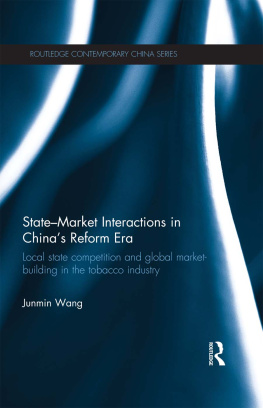In Restraint
of Trade
In Restraint
of Trade
The Business Campaign
Against Competition,
19181938
Butler Shaffer
The Ludwig von Mises Institute
Auburn, Alabama
2008
1997 by Associated University Presses, Inc.
All rights reserved. Authorization to photocopy items for internal or personal use, or the internal or personal use of specific clients, is granted by the copyright owner, provided that a base fee of $10.00, plus eight cents per page, per copy is paid directly to the Copyright Clearance Center, 222 Rosewood Dr., Danvers, Massachusetts 01923.
[0-8387-5325-6/97 $10.00 + 8 pp, pc.]
Associated University Presses
440 Forsgate Drive
Cranbury, NJ 08512
Associated University Presses
16 Barter Street
London WC1A 2AH, England
Associated University Presses
P.O. Box 338, Port Credit
Mississauga, Ontario
Canada L5G 4L8
The paper used in this publication meets the requirements
of the American National Standard for Permanence of Paper
for Printed Library Materials Z39.48-1984.
Library of Congress Cataloging-in-Publication Data
Shaffer, Butler D.
In restraint of trade : the business campaign against competition, 1918-1938 / Butler Shaffer
p. cm.
Includes bibliographical references and index.
ISBN 0-8387-5325-6 (alk. paper)
1. Industrial policyUnited StatesHistory20th century.
2. CompetitionUnited StatesHistory20th century.
3. CompetitionUnited StatesCase studies. 4. Trade regulationUnited StatesHistory20th century. 5. Business and politicsUnited StatesHistory20th century. 6. BusinessmenUnited StatesAttitudes. 7. United StatesEconomic Conditions1918-1945. I. Title
HD3616.U46S43 1997
338.973009041dc 20
96-14519
CIP
SECOND PRINTING 1999
PRINTED IN THE UNITED STATES OF AMERICA
To the memory
and the investigative spirit
of John T. Flynn
Contents
Acknowledgments
I wish to acknowledge my gratitude to a number of persons whose assistance was helpful in the bringing of this book to publication.
First, I would like to thank Robert Love who, knowing of my interest in this subject matter, first encouraged me to write this book more years ago than I care to remember. Shortly thereafter, I received valuable assistance from the late F. A. Harper and Kenneth Templeton, who helped me to focus the scope of this inquiry.
I must also acknowledge the help provided by Mills F. Edgerton, Jr., of Bucknell University Press, as well as Julien Yoseloff and the editors of Associated University Presses. I further wish to express my gratitude to Janet Knoedler for her critical review and analysis of my work. Her perspective and constructive suggestions helped greatly to improve the original manuscript. I also wish to thank my daughtersHeidi, Gretchen, and Bretignefor their invaluable assistance in helping to produce the graphics contained in this book. I also want to acknowledge the help of Jeannie Nicholson and Martha Fink.
Acknowledgment must also be made to the Southwestern University Law Review, which published portions of my research as separate articles in volumes 10 and 20 of the law review. I wish also to acknowledge the following permissions to reprint copyrighted materials contained in this book:
Business and Government, by John T. Flynn. Copyright 1928 by Harpers Magazine. All rights reserved. Reproduced from the March issue by special permission.
The Logic of Collective Action, by Mancur Olson. Reprinted by permission of the publishers from The Logic of Collective Action: Public Goods and the Theory of Groups, by Mancur Olson. Cambridge, Mass.: Harvard University Press, Copyright 1965, 1971 by the President and Fellows of Harvard College.
The Epic of American Industry, by James Walker, 1949. Permission granted by HarperCollins Publishers.
Toward Stability, an editorial appearing in Business Week, 10 May 1933, at page 32. Permission granted by Business Week.
An article appearing in volume 131 of The Iron Age, 25 May 1933, at page 835. Permission granted by Chilton Company, Capital Cities/ABC, Inc.
A Current Appraisal of the National Recovery Administration, by Dudley Cates, in volume 172 of The Annals of the American Academy of Political and Social Science, March 1934, at pages 13234. Reprinted by permission of Sage Publications, Inc.
Two articles, appearing in volume 26 of The Oil and Gas Journal, 2 February 1928, at page 36, and 12 April 1928, at page 36. Permission granted by Oil and Gas Journal.
In Restraint
of Trade
Introduction
[T]he forces which count toward a readjustment of institutions in any modern industrial community are chiefly economic forces; or more specifically, these forces take the form of pecuniary pressure. Such a readjustment as is here contemplated is substantially a change in mens views as to what is good and right, and the means through which a change is wrought in mens apprehension of what is good and right is in large part the pressure of pecuniary exigencies.
Thorstein Veblen
Until relatively recent times, the symbiotic relationship existing between economic and political institutions has only been vaguely comprehended. It has been popular to view these two major sectors of American society as having a generally antagonistic relationship, with political institutions serving as a countervailing force to economic influence. This view is reflected in the traditional conception of economic history that suggests the American business system had, during the late nineteenth and early twentieth centuries, maintained an existence largely independent of, and indifferent to, the interests of the American public. The business community in this era is seen by many as ruthless and hegemonic, exercising nearly unlimited corporate power that threatened the very foundations of a free and competitive economic system. Those who hold to this view insist that the interests of the public required the imposition of political controls to regulate such matters as trade practices, pricing policies, and the size and entry of business firms in the market. It supports a consensus that government regulation of economic activity represents a national policy commitment to elevating the ethical plane of competition in order that market influences may more freely serve some vaguely defined general welfare. One business scholar has reflected this attitude well:
It is not always safe to leave business to its own devices; experience has shown that its freedom will sometimes be abused. Competitors have been harassed by malicious and predatory tactics, handicapped by discrimination, excluded from markets and sources of supply, and subjected to intimidation, coercion, and physical violence. Consumers have been victimized by short weights and measures, by adulteration, and by misrepresentation of quality and price; they have been forced to contribute to the profits of monopoly.
[T]he nations resources have been dissipated through extravagant methods of exploitation. These abuses have not characterized all business at all times, but they have occurred with sufficient frequency to justify the imposition of controls. Regulation is clearly required, not only to protect the investor, the worker, the consumer, and the community at large against the unscrupulous businessman, but also to protect the honest businessman against his dishonest competitor.
This impression of the purposes and effects of the regulatory process is reinforced by a common historical view of the 1920s as the declining years of laissez-faire capitalism, in which big business had its last profligate fling before being brought under the discipline of rational, politically supervised economic planning. Indeed, the so-called Great Depression that ended this decade is generally perceived as one of the high-water marks of corporate dissipation and irresponsibility, ushering in the uncomfortable aftereffects of the 1930s. The New Deal is, to this day, regarded as a major turning point in government and business relationships, and represents to many the inevitable consequences of undisciplined market power. The National Industrial Recovery Act, the Agricultural Adjustment Act, the National Labor Relations Act, and the Fair Labor Standards Act, as well as the operation of intraindustrial agencies such as the Federal Communications Commission, the Securities Exchange Commission, the Civil Aeronautics Board, and the Federal Power Commission, are commonly depicted by historians as having imposed competitive discipline and socially responsible behavior upon a recalcitrant business community.
Next page






